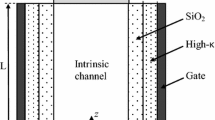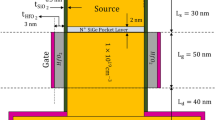Abstract
This paper presents the improvement of an existing design-oriented compact model of the 5-contact vertical Hall-effect sensor integrated in CMOS technology. Such a model should facilitate the work of designers, permitting them to simulate the sensor, the biasing and processing electronics together with the same electrical simulator. Focus is put on the main aspects that alter the electrical response of the sensor: modulation of the conduction channel due to the bias-dependent space charge region thickness, saturation of carrier velocity, asymmetries, and effective channel conduction thickness. The model has been achieved with a subtle mix of theoretical considerations, numerical simulations performed with COMSOL Multiphysics® and experimental data. The parameters extraction procedure is also discussed. The model has been validated on experimental data gathered from two devices, one fabricated in a low-voltage CMOS technology and the other one in a high-voltage CMOS technology. Then, the model is used in order to study offset issues in VHD with external measurement contacts, i.e. VHD integrated in the shallow N-well of low-voltage technologies, and the way the spinning current technique can be used to suppress this offset. A new spinning-current technique is proposed for such a VHD. The simulation results are in perfect accordance with the analytical study. They pave the way for the design of an optimized readout circuitry that may improve the sensor sensitivity while maintaining a very low offset.














Similar content being viewed by others
References
Ramsden, E. (2006). Hall-effect sensors: theory and applications. New York: Newnes.
Kammerer, J.-B., Hébrard, L., Frick, V., Poure, P., & Braun, F. (2003). Horizontal Hall effect sensor with high maximum absolute sensitivity. IEEE Sensors Journal, 3(6), 700–707.
Schell, J.-B. et al. (2012). CMOS 3D Hall probe for magnetic field measurement in MRI scanner.In IEEE NEWCAS Conference (pp. 517–520). Montreal, Canada. doi:10.1109/NEWCAS.2012.6329070.
Pascal, J., Hébrard, L., Kammerer, J.-B., Frick, V., & Bondé, J.-P. (2008). First Vertical Hall Device in standard 0.35 µm CMOS technology. Sensors and Actuators A, 147, 41–46.
Schott, C & Blyzniuk, M. (2012). High volume production of magnetic sensors for the automotive market. In IEEE Sensors Conference (pp. 2086–2089). Taipei, Taiwan. doi:10.1109/ICSENS.2012.6411052.
Schell, J.-B. et al. (2013). Hall-effect magnetic tracking device for Magnetic Resonance Imaging. In IEEE Sensors Conference (pp. 1382–1385). Baltimore, USA. doi:10.1109/ICSENS.2013.6688475.
Huiser, A. M. J., & Baltes, H. P. (1984). Numerical modeling of vertical Hall-effect devices. IEEE Electron Device Letter, 11, 482–484.
Randjelovic, Z., & Popovic, R. S. (1998). Characterization, simulation and macro-modelling of vertical Hall devices. Microelectronics Journal, 29, 715–719.
Dimitropoulos, P., Drljaca, P., Popovic, R., & Chatzinikolaou, P. (2008). Horizontal Hall devices: A lumped-circuit model for EDA simulators. Sensors and Actuators A, 145–146, 161–175.
Dimitripoulos, P.et al. (2007). A completely scalable lumped-circuit model for horizontal and vertival Hall devices. In IEEE Sensors Conference (pp. 337–340).
Madec, M., Schell, J.-B., Kammerer, J.-B., Lallement, C., & Hébrard, L. (2013). Compact modeling of vertical Hall-effect devices: Electrical behavior. Analog Integrated Circuits and Signal Processing, 77(2), 183–195.
Madec, M., Kammerer, J. B., Hébrard, L., & Lallement, C. (2011). An accurate compact model for CMOS cross-shaped Hall effect sensors. Sensors & Actuators A, 171, 69–78.
Madec, M. et al. (2012). Compact modeling of vertical Hall-effect devices: Electrical behavior. In 10th IEEE International NEWCAS Conference (pp. 213–216). Montreal, Canada. doi:10.1109/NEWCAS.2012.6328994.
Sze, S. (2006). Physics of semiconductor devices. New York: Wiley.
Madec, M. et al. (2013). An improved compact model of the electrical behavior of the 5-contact vertical Hall-effect device. In 11th IEEE International NEWCAS Conference (pp. 1–4). Paris, France. doi:10.1109/NEWCAS.2013.6573659.
Madec, M. Osberger, L. & Hébrard, L. (2013). Assessment of the spinning-current efficiency in cancelling the 1/f noise of Vertical Hall Devices through accurate FEM modeling. In IEEE Sensors Conference (pp. 783–786). Baltimore, USA. doi:10.1109/ICSENS.2013.6688323.
Paul, O., Raz, R., & Kaufmann, T. (2012). Analysis of the offset of semiconductor vertical Hall devices. Sensors and Actuators A, 174, 24–32.
Kaufmann, T., Vecchi, M. C., Ruther, P., & Paul, P. (2012). A computationally efficient numerical model of the offset of CMOS-integrated vertical Hall devices. Sensors and Actuators A, 178, 1–9.
Author information
Authors and Affiliations
Corresponding author
Rights and permissions
About this article
Cite this article
Madec, M., Schell, JB., Kammerer, JB. et al. An improved compact model of the electrical behaviour of the 5-contact vertical Hall-effect device. Analog Integr Circ Sig Process 81, 677–691 (2014). https://doi.org/10.1007/s10470-014-0438-2
Received:
Accepted:
Published:
Issue Date:
DOI: https://doi.org/10.1007/s10470-014-0438-2




